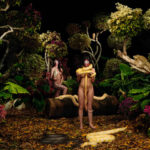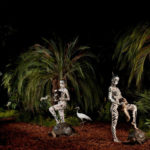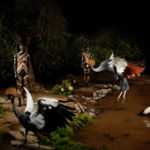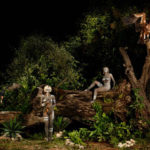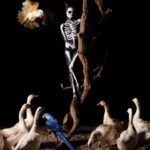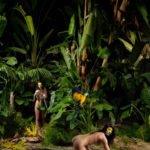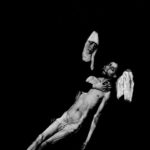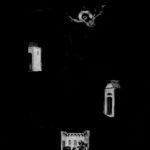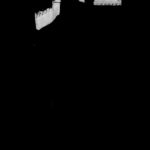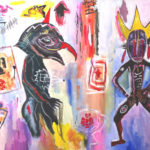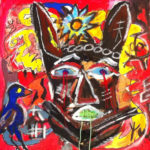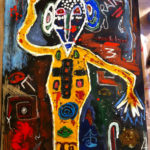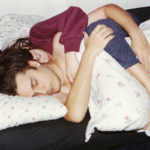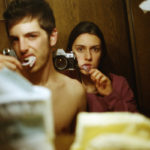
Journey to the End of the Night
Journey to the End of the Night
edited by Alberto Mattia Martini
Dragan Milos, Giulia Bersani, Kamilia Kard, Marco Schifano, Thomas Berra
Gallery SPACE TESTONI in Via D'Azeglio 50 a Bologna, since Friday 22 May to Saturday 04 July 2015 It presents the exhibition of works by five young Italian and foreign artists selected by the art critic and curator Alberto Mattia Martini: Dragan Milos, Giulia Bersani, Kamilia Kard, Marco Schifano e Thomas Berra.
Journey to the End of the Night It is the title that the curator has given this exposure, drawing inspiration from the eponymous book Louis-Ferdinand Céline, to offer some observations on the current forms of expression starting from the creative ways that these five young artists have taken in recent years of difficult social changes, cultural and existential for all humanity.
As written for this exhibition Alberto Mattia Martini:
The title of the exhibition Journey to the End of the Night is inspired by the homonymous book Louis-Ferdinand Céline. A reference deliberately poster and precise, which, however, it does not want to be a simple tribute to the important work of the French writer, but an exhibition that want to conceive a journey into “man night”.
Night as a place where anything can happen, Travel not only tangible but imagination in a rational and unconscious, passing by the power of naturalness to the utopian dreams and the fear of loneliness, through art history and myth, finishing the route in the virtual world.
“Travelling is really useful, ago Use your imagination. Everything else is disappointment and fatigue. The journey that we are given is entirely imaginary. Here is his strength. It goes from life to death. Men, beasts, town and things, everything is invented. It is a novel, nothing but a fictional story. He says Littre, He is never wrong. And in any case everyone can do the same. Just close your eyes. It is the other side of life.”
These words of Céline exert the perception of our journey, introducing us and taking us in the exhibition, dove through the eyes of five young artists we can delve in both the real world and the imaginary, to focus our attention in a fresco of humanity, explore the reality without the excess of imposed filters, surrender to listen to the feelings, groped to regain possession of themselves rejoining the primordial and with nature, and finally build a bridge that unites life and technology.
The exhibition takes the form with nature in dialogue with the human and the animal world, an inescapable and congenital birth, also confirmed the origin of the word nature, which is derived from the Latin verb are born and then tied to the concept of coming into the world. The genesis of the body, after the occurrence, It evolves into a permanent identity, trying to interact and relate, test emotions, istaurando a dialogue with each other, made of love and inevitably of discomfort for a time that elapses inexorable, worn producing absence.
At this point there is no way out? Perhaps we must cling to religion, or the history of the myth, that always has in itself the irrepressible and seductive narrative power to interpret both natural phenomena, that the transcendental.
Another conceivable solution would be to recover our original human nature and distanced himself from the progress that, despite the obvious advantages made, There is nevertheless deprived of reminiscence; no longer seems so essential to remember, so there is the memory of the phone or computer!
We are suspended in limbo, a kind of Garden of delights that is changing into a place of human folly, dominated by violence, cunning and unscrupulous where they take soppravvento increasingly fiercely and morbidly “transient and fleeting pleasures”.
The journey to the end of the night is still long and arduous, the solution is imprinted, written inside the heart of each person; all out melts, You are decomposing, objectivity no longer holds our thoughts, the charm, losing thinking about tomorrow, became disenchanted, the fruitful and opportunities regress enticing the “palate” a few or even only of the self. So what to do? Rethinking the company as a place of encounter with the other and nature, recompose the relationship, love, the embrace, uniting and harmonizing the ego with the Other. We need to restore a true sense of justice and dignity for every individual, the use of technical means as an opportunity and not as a replacement item, but cooperation with man; therefore the technology as a dialogue with history, the past and not only as a vision without memories or experience. All this should not only serve as a list of good intentions, but as Céline wanted to communicate with his work, It must be the individual's revenge on himself.
Alberto Mattia Martini
Milan, 30 April 2015
eXHIBITION PATH
SCHIFANO MARCO
The photographic images in large format Marco Schifano, from Rome, bring into dialogue with the nature of the human being and the animal world.
(1985) lives and works in Rome.
From childhood his "toys" are cameras and cameras, with which grows experiencing its own communication skills. It is practicing the "assembly in the car" to get movies where merges his research on the meaning and rhythm:many hours of footage and a large number of shots to get to their own aesthetic representation of the world.
His most recent photographic work is based on a complex processuality which includes a long preliminary research of coordinated items, assembled and then taken to create highly formalized iconography. The still life is used to re-read the pictorial tradition of the still life, through images that are placed on the threshold between reality and fiction.
THOMAS BERRA
Thomas Berra, from Milan,with the works of his Black Project It offers glimpses of the great paintings of the Old Masters, regaining possession of the myths and values that made them immortal.
In the works of Thomas Berra ( Milan 1986 ) is often evident the need to tell the imaginary, the dream, the real and the living. The artist has in recent years developed various issues under different final forms, with the leitmotiv of his pictorial stamp, fast and synthetic. Map, postcards, drawings, large canvases, small and medium, to outline shapes and themes that leave no doubt: They have ideas, I have visions, They have dreams, are fears, They have secrets. Berra, vivid in his career path, often it stops, leaving precedence to the workings of the imagination.
kAMILIA KARD
The work of net-art the Italo-Hungarian Kamilia Kard who lives and works in Milan, It makes us interact with the characters of Hieronymus Bosch paintings inside a Hell video, of Purgatory, and Paradise, looking for a "virtual" place to identify,
It is the Hungarian-Italian artist born in Milan. He holds a Degree (old order) in Economics (CLEP) at Bocconi University, Milan, (2003), a bachelor's degree in painting at the Academy of Fine Arts of Brera (2012), and a master's degree in Net Art at the Academy of Fine Arts of Brera in Milan (2014). His work focuses on the construction of identity in the Internet age, and it manifests itself through different media, from painting to video and animated gif, prints and installation. Its online projects reflect on the methods of construction of an image, a narrative and an identity that interfaces and communicate in a virtual environment that is real. Semiotics and phenomenology of identity created around these works are an expression of a contemporary world in which the narrative is mediated daily and routinely by various interfaces. An example is Best Wall Cover (2012 – in progress), based on the way people portray on social networks, He has gained a huge popularity. From 2006, He has exhibited in various locations in Italy and in the world. Citing some important recent: AIL - A hand for the happy medium, Fondazione Arnaldo Pomodoro, 2011; Pictures at an Exhibition, contemporary art exhibition space Broletto, Pavia 2012; Videoart Yearbook, Museo del '900, Milan, 2013; la biennale THE WRONG – NEW DIGITAL ART BIENNALE, 2013 – 2014; DASHBOARD – the wrong curators artshow, Kalpany artspace, Milan (Italy) 2014; Powder ES, Palazzo Isimbardi, Milan (Italy) 2014; META, Barracks Municipal Art Gallery, Abrantes (Portugal) 2014; SPAMM Webtics, Wendy Subway, Brooklin, NEW, 2014, Return to dust, Museo Studio Francesco Messina, Milan,2014; NADJA, Hypersalon Miami Beach during Art basel Miami; Internet Drones, ULTRA space, Udine, 2015; SPAMM of VIRTUALISM, New York-Moscow-Paris, 2015, Salon Primo, Bicocca University, 2015 .
The artist also collaborated, together with Paolo Rosa, with as artistic director in interactive projects such as the installation for the MUBA, Rotonda della Besana, Milan during the exhibition Balance and installation Primary Energy at TRIENNALE Milan.
Among his curatorial activities,: Indoor / Outdoor - sensitive Atmospheres, fuorisalone, Milan, 2012; Bestwallcover, online, 2012 ongoing; DASHBOARD – the wrong curators artshow, refrigerators Milan, Milan, 2014,; Internet Drones, ULTRA space, Udine, 2015.
Dragan MILOS
The powerful paintings by Dragan Milos, a native of Sarajevo in Bosnia and now lives between Italy and England, with the strength of line and color can tell us mythological stories and real life.
Born in Sarajevo in 1991, he later moved to Italy where he graduated at the Accademia di Belle Arti in Florence. In Italy he is approaching the Italian painting tradition, the history of art in its broader expressions, focusing on ancient art, in particular investigates the use of “mask” in history and art. Later comes the desire to deepen the medieval art, Renaissance and the study of’ art of the tapestry and weaving, that led him to attend the weaving courses in Sicily, and at the Foundation Arachne in Thessaloniki in Greece.
The artistic research expands, and also focuses on the concept of Myth as a sociological and psychological research of our origins, and paraphrasing Jung, the direct connection between myth and dream, essential insight for understanding the human psyche, the archaic history and contemporary society.
He has exhibited in Bosnia-Herzegovina, Italy and England. Currently she is studying philosophy at the University of Warwick and lives between Italy and England.
GIULIA BERSANI
The photographs in small format of the young Milanese Giulia Bersani show private moments of intimacy where refuge to find ourselves.
Born in Milan in the 'October 1992 I became interested in photography all 'age of eighteen through a course organized by the scientific high school I attended. During the first years of university I attended the evening course in analog and digital photography at the CFP Bauer and I started, thanks to my photographs, to attract the attention of some blogs and magazines including among others the Oeil de la Photographie, Pizza magazine, Inside Art, Ignant and GUP magazine. They quickly passed by the Faculty of Fashion Design to that of cultural sciences and then make the decision to interrupt his studies and devote himself entirely to photography. In the following months I took part in several collective exhibitions in Italy and the United Kingdom and in February 2014 I self-published limited edition book "Lovers", collection of unpublished photographs in black and white on the theme of intimacy and dependence in the couple, exhausted in a short time. In the following months I continued to take forward projects such as "21", project of self-portraits in which narrative my daily realistically (including the moments of boredom) e “Stronger”, portrait of a Neapolitan family. in February 2015 I self-published "Lovers II", this time containing a series of color photographs in which you can see the evolution of my point of view (this time less dramatic) with respect to the first part of the project. The latter was presented during my first solo exhibition at MyCamera, Ravenna.
Further information:
Melancholy temperament and introvert, I struggle to feel comfortable in social situations open; for this to take pictures of other things I needed my time and space that allow me to create a relaxed and intimate atmosphere through dialogue. The way in which the photographer is not aggressive, rather reflexive; I try me and I find myself in my subject.
I think one of the main reasons that lead me to take photographs is the fear of death and loss and therefore the need to retain everything that I am fond: couple relationships, the details and the human flaws, the characteristics of the time in which live, of my age, My country etc..
I choose subjects in which I mirror I though often unknown; in many cases I find them through the internet. I like to go for a few hours in their lives and take away a memory, an image that then every observer will own linking it to personal experience.
Photographer almost film only for the sense of materiality that can give me and I do not find that in the digital.


